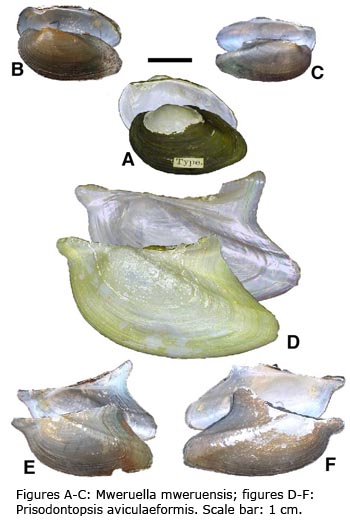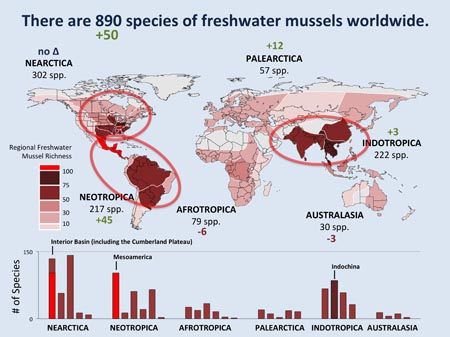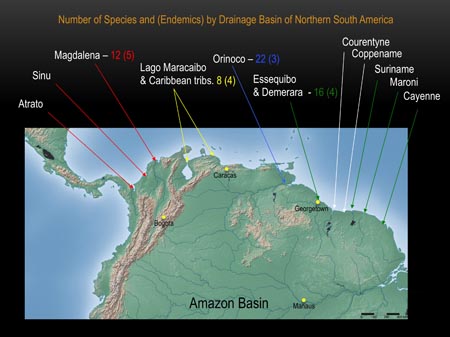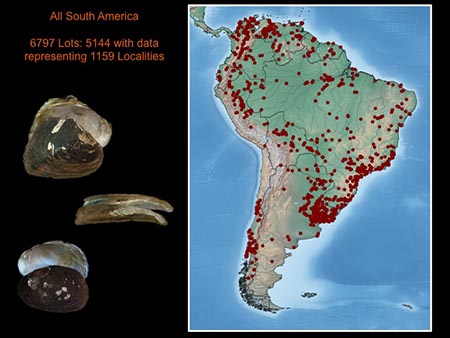| Page last updated
5 January 2015 |
2014 MUSSELp Publications & Presentations
Phylogenetic analysis of Prisodontopsis Tomlin, 1928 and Mweruella Haas, 1936 (Bivalvia: Unionidae) from Lake Mweru (Congo Basin) supports a Quaternary radiation in the Zambian Congo
by Daniel L. Graf, Anthony J. Geneva, J.M. Pfeiffer III & Alex D. Chilala
Published 2014, Journal of Molluscan Studies 80(3): 303-314. Click here for electronic access.
 Abstract. The freshwater mussels Prisodontopsis aviculaeformis ( F.R. Woodward, 1991) and Mweruella mweruensis ( E.A. Smith, 1908) are endemic to Lake Mweru and confluent rivers in Zambia and the Democratic Republic of Congo in southcentral Africa. Each species has traditionally been regarded as monotypic at the genus-level or above. We assessed the phylogenetic relationships of these two species together with species of Coelatura, Nitia and three outgroup species (35 terminals representing 11 species in total) using two gene fragments, 28S nuclear rDNA and cytochrome oxidase subunit I mtDNA. Maximum parsimony, maximum likelihood and Bayesian inference provided strong support for a sister relationship between P. aviculaeformis and M. mweruensis as well as evidence of incomplete lineage sorting or introgression between them. This Lake Mweru clade was resolved as sister to a clade composed of Coelatura choziensis (Preston, 1910) and C. luapulaensis (Preston, 1913) from Lake Bangweulu and the adjacent Chambeshi River. These four species from the Zambian Congo were nested within a paraphyletic Coelatura Conrad, 1853. We advocate placing Mweruella Haas, 1936 as a subjective junior synonym of Prisodontopsis Tomlin, 1928, while maintaining Coelatura as paraphyletic until a more comprehensive phylogeny is available. We hypothesize that the endemic freshwater mussels of Lake Mweru in the Zambian Congo evolved within the lake during the Quaternary from an ancestor originating in the Chambeshi River following stream capture from the Zambezi Basin. Abstract. The freshwater mussels Prisodontopsis aviculaeformis ( F.R. Woodward, 1991) and Mweruella mweruensis ( E.A. Smith, 1908) are endemic to Lake Mweru and confluent rivers in Zambia and the Democratic Republic of Congo in southcentral Africa. Each species has traditionally been regarded as monotypic at the genus-level or above. We assessed the phylogenetic relationships of these two species together with species of Coelatura, Nitia and three outgroup species (35 terminals representing 11 species in total) using two gene fragments, 28S nuclear rDNA and cytochrome oxidase subunit I mtDNA. Maximum parsimony, maximum likelihood and Bayesian inference provided strong support for a sister relationship between P. aviculaeformis and M. mweruensis as well as evidence of incomplete lineage sorting or introgression between them. This Lake Mweru clade was resolved as sister to a clade composed of Coelatura choziensis (Preston, 1910) and C. luapulaensis (Preston, 1913) from Lake Bangweulu and the adjacent Chambeshi River. These four species from the Zambian Congo were nested within a paraphyletic Coelatura Conrad, 1853. We advocate placing Mweruella Haas, 1936 as a subjective junior synonym of Prisodontopsis Tomlin, 1928, while maintaining Coelatura as paraphyletic until a more comprehensive phylogeny is available. We hypothesize that the endemic freshwater mussels of Lake Mweru in the Zambian Congo evolved within the lake during the Quaternary from an ancestor originating in the Chambeshi River following stream capture from the Zambezi Basin.
Data. grafetal2014.txt |
Mollusca: Bivalvia
 by Kevin S. Cummings & Daniel L. Graf by Kevin S. Cummings & Daniel L. Graf
Published 2014, Chapter 19 in J. Thorp & D.C. Rogers (eds.), Ecology and General Biology: Thorp and Covich's Freshwater Invertebrates, Academic Press-Elsevier, New York. pp. 423–506.
The freshwater bivalves of North America are represented by two native groups, the freshwater mussels and the pill, fingernail, and pea clams, as well as two widely publicized invasive genera, Corbicula and Dreissena. These mollusks have interesting and important ecological interactions with their environments, not the least of which is their relationship to humans. As regards freshwater mussels (also called pearly mussels or naiads), humans have been among their most potent enemies, but today considerable resources are dedicated to reversing the wave of decline and extinction that these mollusks face. Conversely, the minute sphaeriids have received comparatively less attention.
|
A Biodiversity Informatics Assessment of Wisconsin Freshwater Mussels
by Charles Jordan & Madalyn Zimbric
Poster presented at the University of Wisconsin Stevens-Point College of Letters and Sciences Undergraduate Research Symposium, 2 May 2014.
Abstract. While previous projects have gathered literature references to Wisconsin mussel presence, there has been no integrated database of verifiable mussel observations linked with location data. We started with a database with approximately 17000 records, 8619 of which are linked to specimens collected from Wisconsin. We compiled records from the Milwaukee Public Museum, Illinois Natural History Survey, Academy of Natural Science of Philadelphia, Museum of Comparative Zoology Harvard, University of Michigan Museum of Zoology, and the Wisconsin Department of Natural Resources. We then georeferenced each record to its collection site and are now able to generate maps using subsets of these records. Using these georeferenced records, we will be able to confirm species richness for Wisconsin counties and use these data to generate hypotheses regarding assemblages of species associated with river basins. These data can also be used determine similarity of species diversity between basins and perhaps test hypotheses regarding patterns of post-glaciation invasion of mussels into Midwestern water basins. We will also be able to use these distributions to correct misidentifications and data errors within these collections. |
|
|
Curation of the Daniel Bereza Mollusk Collection at the Smithsonian National Museum of Natural History
by Caitlin M. Luebke & Rachel Sommer
Poster presented at Mollusca 2014: Encuentro de las Américas at the Universidad Nacional Autónoma de México, Mexico City, Mexico, 23-26 June 2014. A similar version was presented at the at the University of Wisconsin Stevens-Point College of Letters and Sciences Undergraduate Research Symposium, 2 May 2014.
Abstract. In 2011, the Smithsonian National Museum of Natural History (NMNH) acquired a collection of preserved mollusks and associated field notes from the family of Daniel Bereza (1950‐2007), formerly of the Academy of Natural Sciences in Philadelphia, Pennsylvania. These field notes contain an entry for each collecting event, which include the localities of the collecting sites and lists of the species found. In January 2013, we began the process of accessioning this collection into the NMNH. We built a database of the collecting events by capturing the field notes verbatim, converting digital images of handwritten notes to searchable text strings. We learned that the field notes contain entries for over 700 collecting events between 1971 and 1984. We then normalized the collection event data into separate fields (collectors, state, county, water body, etc.) and georeferenced the localities. In January and March 2014, each specimen lot was identified and prepared for incorporation into the NMNH catalog. The collection contained 66 freshwater mussel (Order Unionoida) species from 15 U.S. states and 28 freshwater mussel species from 4 Mexican states. Our primary research interest in the Bereza Collection is the freshwater mussels from México. In general, the freshwater mussels of Central America have been understudied. The curation of this collection will facilitate a long overdue revision of the Central American freshwater mussel fauna. We would like to thank Robert Hershler of the Smithsonian and the UEI grant from the College of Letters and Sciences, University of Wisconsin‐Stevens Point for funding this project. We would also like to thank Daniel Graf of the University of Wisconsin‐Stevens Point and Kevin Cummings of the Illinois Natural History Survey for their support and guidance. |
|
OK, Let's Try This Again: A Re-Assessment of Global Freshwater Mussel Diversity (Bivalvia: Unionoida)
by Daniel L. Graf & Kevin S. Cummings
Presented at Mollusca 2014: Encuentro de las Américas at the Universidad Nacional Autónoma de México, Mexico City, Mexico, 23-26 June 2014.
Abstract. In 2007, we published the first checklist of global freshwater mussel (Order Unionoida) diversity since Haas’s in 1969, and we have periodically updated the list on the MUSSEL Project Web Site (http://www.mussel‐project.net/). The occasions of multiple faunistic updates (including South America, Africa, China, the Ganga Basin, Japan, and Alabama), new phylogenetic data, and a contract from the Integrated Taxonomic Information System (http://www.itis.gov/) have motivated us to re‐assess the geographic and taxonomic patterns of Recent freshwater mussel species richness. We have assembled a comprehensive database of freshwater mussel nominal species, each has been assigned to a valid species (or nomen dubium) based on published synonymies. To‐date, we have gathered >57,000 taxonomic opinions about 4952 nominal species and subspecies. The Order Unionoida is comprised of six extant families: Unionidae (684 spp.), Margaritiferidae (13), Hyriidae (96), Mycetopodidae (53), Iridinidae (40), and Etheriidae (4) — a total of 890 species and a net gain of 50 over our 2007 assessment. Geographically, we divide the fresh waters of the world into six realms: Nearctica (302 total spp., 20 synonymized from the previous assessment, 16 resurrected from synonymy, 2 newly described), Neotropica (217, 1, 45, 1), Afrotropica (79, 4, 0, 0), Palearctica (57, 0, 10, 2), Indotropica (222, 9, 7, 6), and Australasia (30, 2, 0, 0). In addition, we have synonymized with valid Palearctic species two new nominal species recently described by the Russian Comparatory School. We will present data on finer scale patterns of taxonomic and geographical species richness, as well as provide suggestions for future research. |
 |
This slide depicts the hotspots of freshwater mussel richness in the known universe. |
|
The Freshwater Mussels (Bivalvia: Unionoida) of Colombia, Venezuela, the Guianas and Suriname, South America
by Kevin S. Cummings & Daniel L. Graf
Presented at Mollusca 2014: Encuentro de las Américas at the Universidad Nacional Autónoma de México, Mexico City, Mexico, 23-26 June 2014.
Abstract. The South American river basins north of the Amazon (including the Rios, Magdalena, Sinu, Orinoco, Essequibo, as well as smaller systems of Guyana, French Guiana and Surinam) are inhabited by three families of freshwater mussels: Hyriidae, Mycetopodidae, and Etheriidae. Our systematic re‐evaluation of the species and genera of the region is based on fieldwork conducted with KSC in collaboration with Christine A. Mayer (1986‐1995), collections‐base research in 17 major research collections, and a comprehensive literature review. Digital photographs of specimen lots and geoferenced localities were integrated into a comprehensive database of freshwater mussel taxonomy, literature records, and museum specimens. To‐date, we have captured >650 specimen lots from the region and nearly 7000 from South American generally (including >500 primary and secondary type lots). These data are publicly available via the MUSSEL Project Web Site (http://www.mussel‐project.net/). We currently recognize 37 species in 12 genera in the region, including at least one species new to science. Of these species, 20 are endemic to the region. We will present our results on patterns of species richness and taxonomic diversity in these Neotropical basins and summarize the known deficiencies in our understanding of the biogeography and evolution of these taxa. This research was funded by grants from the USA National Science Foundation (DEB‐REVSYS‐0316125, 0316488). |
 |
This slide depicts patterns of freshwater mussel species richness and endemism in northern South America. |
|
The Freshwater Mussels (Bivalvia: Unionoida) of Northern South America and the Amazon
by Kevin S. Cummings
Presented at the 7th Congress of the European Malacological Societies at St. Catherine's College, Cambridge, UK, 7-11 September 2014.
Abstract. The river basins of Northern South America (NSA) (including the Rios, Magdalena, Sinu, Orinoco, Essequibo, as well as smaller systems of Guyana, French Guiana and Surinam) and the Amazon are inhabited by three families of freshwater mussels: Etheriidae, Hyriidae, and Mycetopodidae. Our systematic re-evaluation of the species and genera of the region is based on fieldwork conducted by KSC in collaboration with Christine A. Mayer (1986-1995), collections-based research in 17 major research collections, and a comprehensive literature review. Digital photographs of specimen lots and geo-referenced localities were integrated into a comprehensive database of freshwater mussel taxonomy, literature records, and museum specimens. To-date, we have captured nearly 30,000 specimen lots: 6800 from South America, about 650 from NSA, and 1130 lots from the Amazon basin. These data are publicly available via the MUSSEL Project Web Site (http://www.mussel-project.net/). We currently recognize 37 species in 12 genera in NSA, including at least one species new to science and approximately 50 species in 14 genera in the Amazon. Of these species, 20 are endemic to NSA and about 16 in the Amazon. A few species are shared between northern South America and the Amazon through connections between the Orinoco and Amazon though the Casiquiare Canal and the Essequibo and Amazon via the upper Rio Branco. We will present our results on patterns of species richness and taxonomic diversity in these Neotropical basins and summarize the known deficiencies in our understanding of the biogeography and evolution of these taxa. |
 |
This slide depicts the 1159 freshwater mussel localities represented in museum collections in the United States and Europe. |
|
|